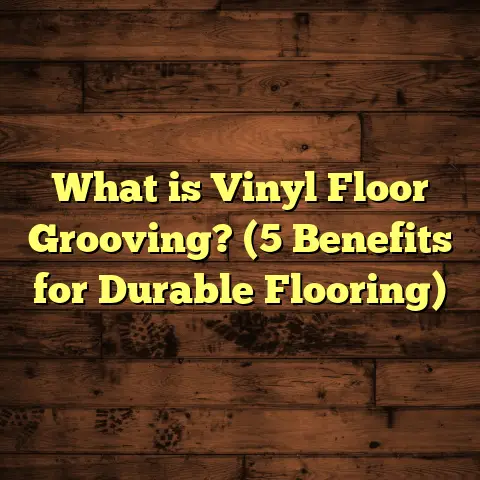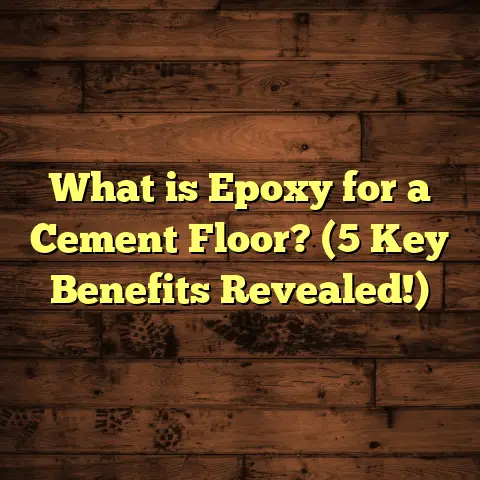What is Marmoleum Flooring? (5 Benefits for Sustainable Homes)
Warmth — it’s one of those simple things that makes a house feel like a home. I don’t just mean the heat from a cozy fireplace or sunlight streaming through the windows. I’m talking about the feeling you get when you walk barefoot on a floor that welcomes you, invites you to stay, and doesn’t just look good but feels good too. Over the years, as I’ve installed floors in countless homes and spoken with so many clients, I’ve realized something important: the right flooring sets the tone for the entire living space.
One flooring type that really stands out in this respect is Marmoleum. If you haven’t heard much about it, or if you’re curious whether it’s worth considering for your home—especially if sustainability matters to you—stick with me. I’ll take you through everything I know about Marmoleum flooring, what makes it unique, and why it’s an excellent choice for people who want their homes to be warm, healthy, and environmentally responsible.
What is Marmoleum Flooring?
Marmoleum is a brand name many folks use interchangeably with linoleum flooring, but it’s actually a specific type of linoleum made by the company Forbo. So what exactly is Marmoleum? At its core, it’s a floor covering made from natural raw materials—linseed oil, wood flour, jute (a natural fiber), pine rosin (a resin), and natural pigments for color. This mix gets pressed onto a jute backing, resulting in a sheet or tile that is flexible yet durable.
Unlike vinyl flooring, which is petroleum-based and synthetic, Marmoleum is biodegradable and renewable. The linseed oil is extracted from flax seeds—a fast-growing plant that requires relatively little water and pesticides compared to other crops. The wood flour used typically comes from sustainable forestry byproducts. Plus, Marmoleum’s manufacturing process locks in carbon dioxide, which helps reduce overall greenhouse gases.
When I first encountered Marmoleum, I was surprised by its versatility. It comes in all sorts of colors—from vibrant reds and greens to soft pastels and natural earth tones—and patterns ranging from classic marbled looks to intricate geometric designs. This makes it suitable for everything from cozy living rooms to high-traffic commercial spaces.
You might ask: is it comfortable? Yes! Marmoleum feels warm underfoot because of its natural composition. Unlike cold tiles or hard vinyl, its texture offers a bit of softness while still being firm and supportive.
How Is Marmoleum Made?
Understanding the manufacturing process helps explain why Marmoleum is such a sustainable choice. Here’s a quick overview based on my research and discussions with suppliers:
- Flax seeds are harvested and pressed to extract linseed oil.
- The linseed oil undergoes oxidation to create a thick binder called “linoleum cement.”
- Wood flour (finely ground wood fibers) and pine rosin are mixed with pigments.
- The linoleum cement binds these ingredients together.
- The mixture is rolled onto a jute backing in thin sheets.
- Sheets are then pressed and cured in ovens to harden.
- Finally, the surface gets sanded and coated with protective finishes like natural wax or water-based polyurethane.
This process uses minimal synthetic chemicals and generates very little waste.
Why Do I Recommend Marmoleum? Five Benefits for Sustainable Homes
Since I started working with Marmoleum, I’ve noticed how often clients express surprise at both its quality and eco-friendly attributes. It’s not just another flooring option; it’s a conscious choice that reflects values related to health, durability, and environmental impact.
1. True Environmental Friendliness
I care deeply about materials that don’t cost the earth—literally. Marmoleum is made from over 97% renewable resources, which means most of its ingredients come from plants or sustainably harvested wood.
What does this mean in practice? When you install Marmoleum floors, you’re reducing your carbon footprint compared to synthetic alternatives like vinyl or laminate that rely heavily on fossil fuels. This isn’t just marketing fluff either. Independent life-cycle assessments show that producing Marmoleum results in 60% less greenhouse gas emissions compared to vinyl flooring.
Plus, because it’s biodegradable, Marmoleum won’t sit in landfills for centuries after disposal. It breaks down naturally without releasing harmful toxins—a huge plus given how many synthetic floors end up as waste.
I remember working on a project for a family who wanted a zero-waste kitchen remodel, including flooring. They were thrilled to choose Marmoleum because it aligned perfectly with their values—knowing their floor was made from plants and could return to the earth gave them tangible peace of mind.
2. Long-Lasting Durability
A common misconception about natural materials is they might wear out faster. But Marmoleum surprises many by lasting up to 40 years with proper care—sometimes even longer!
On several projects where I installed Marmoleum in high-traffic areas like kitchens and hallways, the floors held up beautifully against scratches, dents, stains, and everyday wear. The secret lies in how the natural oils cure during production, creating a tough surface.
Here’s an interesting data point: compared to hardwood flooring that can dent or scratch easily without refinishing, Marmoleum requires less maintenance over time while maintaining its appearance.
One homeowner with two kids and a dog told me she was amazed her floors still looked pristine after two years of heavy use without any special treatments beyond regular cleaning.
3. Healthier Indoor Environment
Indoor air quality matters more than most people realize—especially if you have allergies, asthma, or sensitive skin.
Marmoleum releases zero volatile organic compounds (VOCs) once installed. VOCs are chemicals found in many synthetic flooring materials that can off-gas harmful fumes for months or years after installation.
Even better: Marmoleum’s natural composition includes antibacterial properties thanks to linseed oil. It inhibits bacteria growth on the floor surface without harsh chemicals or added coatings.
One client with asthma issues saw significant improvements after switching from carpet to Marmoleum throughout her home because dust mites and allergens weren’t trapped as much on hard surfaces.
4. Easy Maintenance Saves Time and Money
Who enjoys spending hours scrubbing floors? Not me—and definitely not my clients! One major benefit of Marmoleum is how simple it is to keep clean.
Routine maintenance usually involves sweeping or vacuuming dust and occasional mopping with mild soap and water. There’s no need for special cleaners or waxes that can introduce chemicals into your home or damage the surface over time.
I recall working with a busy family who hated floor care chores but loved how their Marmoleum kitchen stayed clean with minimal effort. They told me they saved both time and money compared to their previous hardwood floors that needed refinishing every few years.
Additionally, because the floor resists stains naturally, spills don’t soak in as easily as on porous materials like carpet or unsealed wood.
5. Beautiful Design Versatility
Design matters to me; I want floors that feel like part of the home’s personality. Marmoleum offers an impressive range of colors and patterns—more than 300 variations in some collections—allowing you to create everything from subtle backgrounds to bold design statements.
One project I worked on involved installing Marmoleum tiles arranged in a checkerboard pattern with alternating bright yellow and gray colors for a modern office space. The client loved how vibrant the floor looked without sacrificing comfort or durability.
Colors typically don’t fade over time because pigments are mixed directly into the material rather than just painted on top.
My Advice for Anyone Considering Marmoleum Flooring
From my hands-on experience installing Marmoleum in different environments—homes, offices, boutiques—I’ve picked up some tips that make all the difference:
Acclimate Before Installation
Natural materials react to temperature and humidity changes. I always recommend letting Marmoleum sheets or tiles sit in the room where they will be installed for at least 48-72 hours beforehand.
Opt for Professional Installation
While some DIY enthusiasts might be tempted to install Marmoleum themselves, I suggest hiring pros unless you have specific experience.
Proper installation ensures tight seams and smooth surfaces which impact both durability and appearance long term.
Use Protective Finishes
Although Marmoleum comes with a durable surface, applying an additional water-based polyurethane finish helps protect against moisture and scuff marks without compromising breathability.
I personally prefer finishes that are low-VOC and compatible with sustainable living goals.
Prepare Your Subfloor Well
A flat, clean subfloor is crucial since any imperfections will show through the thin Marmoleum layer over time.
Make sure your subfloor is level within manufacturer specs before installation begins.
Consider Radiant Heating Compatibility
If you plan radiant floor heating beneath your floors, Marmoleum works quite well due to its natural insulating properties—just ensure your installer follows recommended temperature ranges to avoid damage.
Cost Considerations: How FloorTally Helps Me Stay Accurate
Budgeting for flooring can get complicated fast—materials vary by brand and quality; labor costs fluctuate based on location; installation difficulty adds complexity; waste factors can be overlooked leading to shortages…
For me, FloorTally has been a game changer in managing costs efficiently (and honestly reducing stress).
This online tool lets me input specific project details such as:
- Square footage
- Local labor rates
- Material type (like Marmoleum)
- Waste factor (usually around 5-7%)
- Additional costs (like underlayment or finishes)
Once these inputs are entered, FloorTally produces detailed cost estimates breaking down material costs versus labor and extras clearly.
This helps me give clients realistic budgets upfront and avoid surprises later on in the project timeline.
If you’re planning your own flooring work or comparing contractor quotes, using tools like FloorTally can simplify decision-making by consolidating numbers into one easy-to-understand summary instead of juggling spreadsheets or multiple quotes yourself.
What Real-World Data Tells Us About Marmoleum Floors
In my own projects and industry research, here are some significant statistics I found useful:
| Metric | Value / Range | Source |
|---|---|---|
| Percentage of renewable content | Over 97% | Forbo (manufacturer) |
| Expected lifespan | 25 – 40 years | Various installation case studies |
| Carbon footprint reduction | ~60% less than vinyl flooring | Life-cycle assessment studies |
| Maintenance frequency | Monthly sweeping/biweekly mopping | Installer and homeowner feedback |
| Average cost per square foot | $7 – $12 (material only) | Market pricing surveys |
Several case studies highlight families reporting satisfaction ratings between 8-10 out of 10 after installing Marmoleum floors in kitchens, bedrooms, offices, and retail spaces.
One particularly interesting study compared indoor air quality before/after replacing carpet with Marmoleum in a daycare center; results showed reduced airborne allergens by over 30%.
My Personal Stories With Marmoleum Floors
I’ll share a couple of moments that stick out from my work:
- The family kitchen transformation: A client wanted a kitchen floor that was eco-friendly yet kid-proof. After installing olive-green Marmoleum tiles arranged in diagonal patterns, they told me their two toddlers loved crawling on the “soft but sturdy” floor—and they didn’t worry about spills staining it.
- The boutique makeover: For a small retail store focusing on handmade goods, we chose colorful patterned Marmoleum tiles reflecting local artisan motifs. The owner said customers complimented how “warm and inviting” the space felt—something she didn’t expect from linoleum but loved once it was done.
Wrapping Up: Is Marmoleum Flooring Right for You?
If you’re someone who values warmth—not just temperature-wise but emotionally—and wants a flooring option that respects nature while standing up to everyday life, Marmoleum deserves your attention.
It combines natural beauty with practical benefits like durability, easy maintenance, improved indoor air quality, and strong environmental credentials. Plus, its design flexibility lets you match any style or mood without compromise.
Have questions about whether it fits your space? Want help estimating costs realistically? Feel free to reach out—I’m always happy to share insights based on real-world experience.





